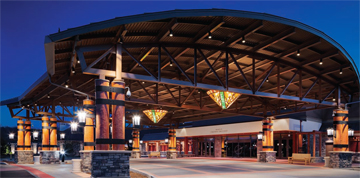
South Bend, Indiana is most famous as home of one of the
legendary universities in the U.S., Notre Dame. From the Touchdown Jesus mural near the stadium to the Golden Dome, Notre Dame has been the focal point of South Bend for generations.
Now South Bend has another focal point: the first tribal casino in the state of Indiana. The Pokagon Band of Potawatomi Indians operates several casinos in Michigan and has roots in Indiana. After going through the “land-into-trust” process, it built an extraordinary casino in South Bend.
As an extension of the Four Winds brand, the South Bend property opened to the public in January. As with the other Four Winds properties, it integrates tribal symbolism into the guest experience with tailored elements that relate to the South Bend market.
“Over the past 10 years, architects and interior designers at HBG Design have built an ongoing relationship with the Pokagon Band and Four Winds in Michigan and Indiana,” says Paul Bell, project manager and principal at HBG. “Our team has worked to strategically enhance the design quality and aesthetic over their four-property, now multi-state, brand.”
Designers helped the brand evolve from very traditional to more transitional in design, in part to appeal to broader guest demographics. Within a high-contrast, contemporary aesthetic, unique tribal motifs are showpiece
elements balanced proportionately with rich, dark wood tones, geometric
ceiling patterns, a sophisticated palette of tile, stone and wooden finishes, leather-look upholstery and intricate flooring patterns that relate to aspects of tribal heritage.
“The Pokagon call South Bend ‘Ribbontown,’” says Nathan Peak, lead architectural designer and principal at HBG Design. “Known for arts and crafts, tribal symbolism is connected to unique patterns and artwork as well as the tribe’s original location on the river and water.”
A standout for the 175,000-square-foot South Bend property is the large dramatic rotunda entry, which connects key amenities within: the 1,800-slot casino with a dedicated 40-machine non-smoking area; a casino center bar; retail space; a coffee shop; and four new dining experiences, including Copper Rock Steakhouse, the Buffet,
Kankakee Grille and Timbers.
The Potawatomi consider copper a sacred healing metal and the Pokagon are descendants of the Copper Culture people, an ancient indigenous tradition and lifeway of early inhabitants of
northern Michigan and Wisconsin. Ancestors fashioned copper found in this Great Lakes region into tools, adornments and weapons. Modern Pokagons value copper still, especially as vessels for life-giving water in ceremonies.
Two found “float copper” rocks from Michigan’s Northern Peninsula were installed at the entrance of the Copper Rock Steakhouse. Each is well over 11,000 years old, and the two weigh five tons combined. The largest, placed within a dedicated niche at the steakhouse entry façade, stands more than 10 feet high and 5 feet wide. The smaller rock was placed in the main dining room of Copper Rock Steakhouse. Roughly 3,500 pounds, this specimen is roughly 4 feet tall and 3 feet wide.
OWNER: Pokagon Band of Potawatomi Indians
ARCHITECT: HBG Design
BUILDER: F.A. Wilhelm of Indianapolis
FEATURES: 175,000 square feet of overall space, 1,800 Class II slot machines, four restaurants, three bars and 4,500 parking spaces





